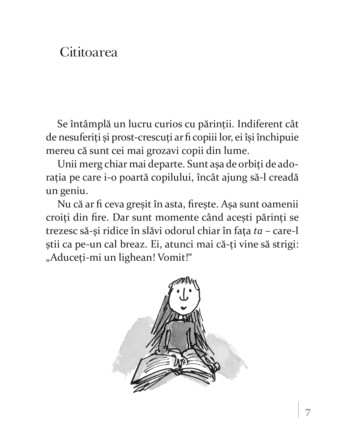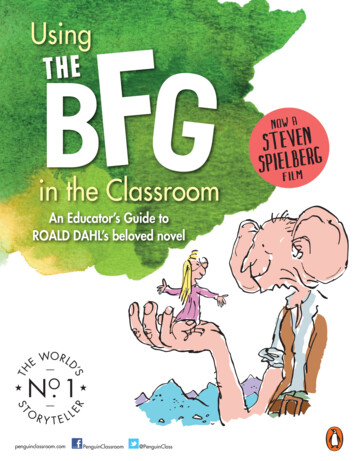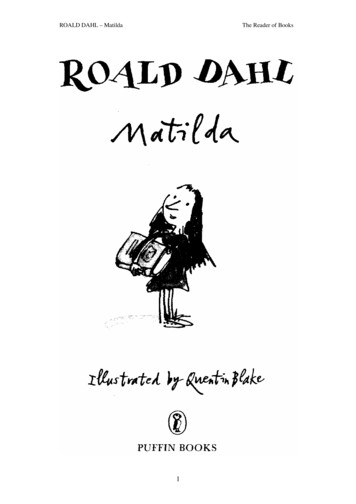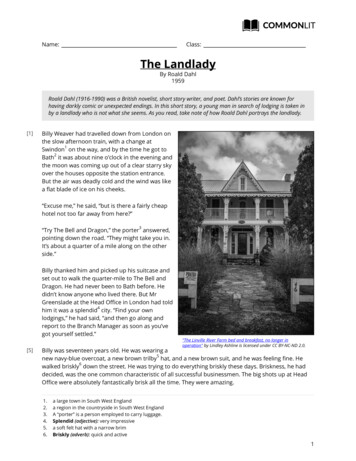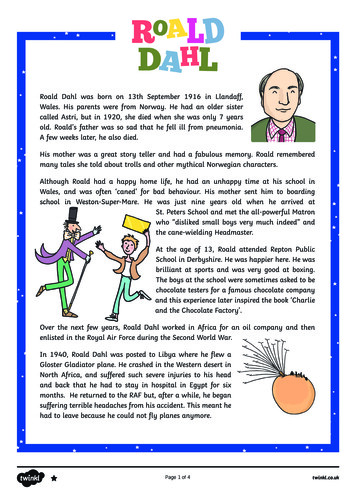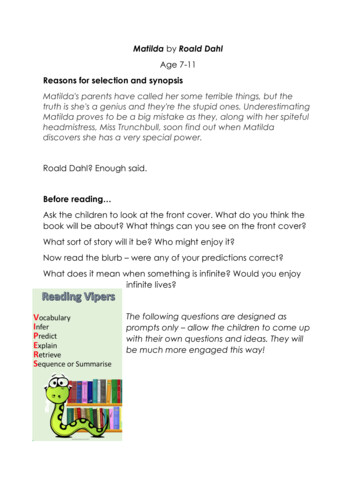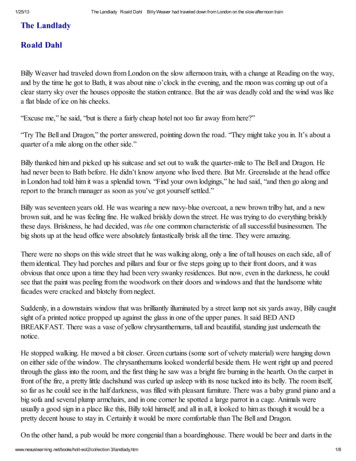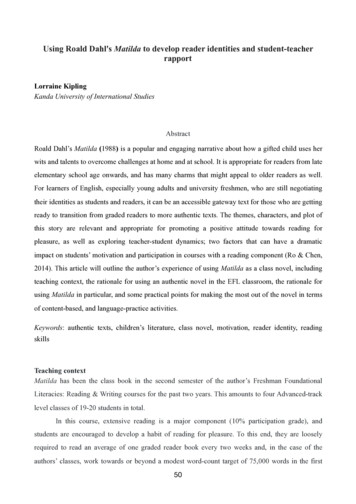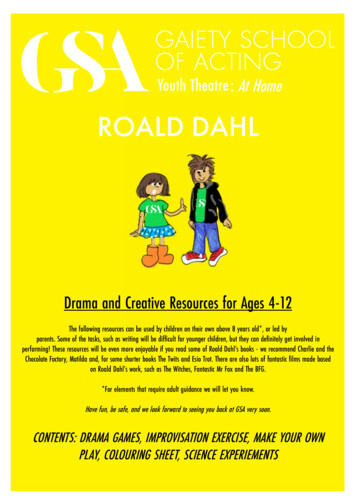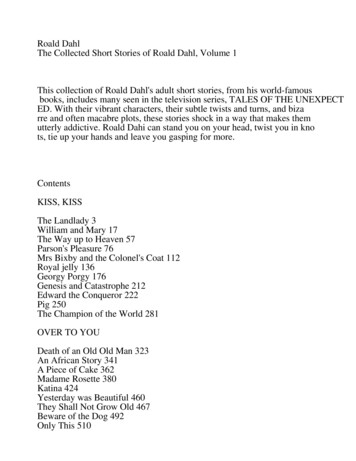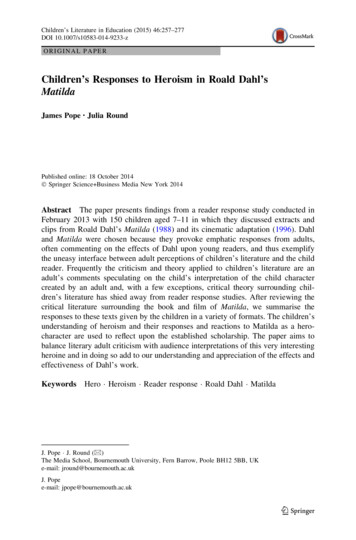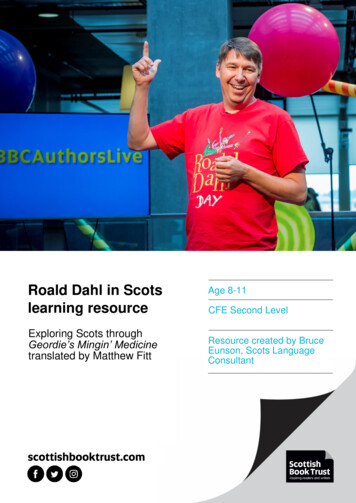
Transcription
Roald Dahl in Scotslearning resourceExploring Scots throughGeordie’s Mingin’ Medicinetranslated by Matthew FittAge 8-11CFE Second LevelResource created by BruceEunson, Scots LanguageConsultant1
ContentsAbout this resource1Listening to Scots2Reading in Scots2Understanding Scots narration4Speaking in Scots4Scots instructions5Writing in Scots: an extra guid pliskie5Performing Scots6Scots language is.8About this resourceThis resource will help you to run a project on Scots language in the classroomthrough reading Geordie’s Mingin Medicine, a Scots translation by Matthew Fitt ofRoald Dahl’s George’s Marvellous Medicine, as a class.The activities within this resource pack link to Geordie’s Mingin Medicine but couldeasily be adapted to other Scots language translations of Roald Dahl favourites suchas The Eejits or Chairlie and the Chocolate Works, published by Scots publisherItchy Coo.It is recommended that this resource be used with learners who are already familiarwith Scots.For a more general introduction to Scots, take a look at our learning resource onusing Scots in the classroom. If you would like explore Scots with a simpler text,explore the Education Scotland resources for The Gruffalo in Scots.1
Listening to ScotsLIT 2-01a, ENG 2-03a, LIT 2-14aThis section will help you to introduce Scots in the classroom before you startreading Geordie’s Mingin Medicine.To get your class familiar with the sound of Scots being read aloud, here are somevideos and recordings of Scots you could play to the pupils: Bookbug songs and rhymes in Scots James Robertson reading The Gruffalo in Scots on Authors Live Matthew Fitt reading Chairlie and the Chocolate Works on Authors Live Recordings of excerpts and poems, including Tam O Shanter by RobertBurns, from Scots Language Centre The Scots Language Centre’s recording of The Tale O Peter Kinnen,translated into Scots by Lynne McGeachie and published by the Beatrix PotterSocietyYou could also watch the full video of Matthew Fitt on Authors Live, where he talksabout Chairlie and the Chocolate Works and why Scots is so important to him. Tryjoining in with the activity after the reading of Chairlie, in which Matthew gives thestudio audience a series of instructions in Scots (such as “pit yer hauns on yer heid”and “point tae yer mooth”) around 20 minutes into the broadcast.Researching ScotsAsk pupils to choose one word from one of the recordings above that they like, orwhich they don't know the meaning of. This could be anything, such as mingin,glaikit, unco, skirl and bahookie!Pupils can then research the word online, starting with the online Dictionary of theScots language.Once pupils have more information on their chosen word, ask them to look intohow its use and definition is linked to the history of Scotland. For example, pupilsmight try to find out how their chosen word has changed over time, or why it hasfallen out of use.Reading in ScotsLIT 2-04a, LIT 2-05a, LIT 2-09a, LIT 2-10a, ENG 2-03aOnce pupils feel comfortable and familiar with the sounds of Scots, start readingchapter one of Geordie’s Mingin Medicine, titled ‘Grannie’. If you or any of the pupilsare particularly confident with Scots, the chapter could be read aloud.2
Read from the beginning up to the first illustration then pause to have a classdiscussion. Before you start the discussion, ask pupils to explain what has happenedso far, to ensure everyone can follow the story.DiscussionThe story is written in prose, entirely in Scots language. What examples of Scots isthere from the opening few pages? Do the pupils in the class already use any ofthese words themselves? Translate and discuss the meaning of each.Some Scots words are similar to English, such as ‘oot’, ‘jist’, ‘wis’, ‘dug’. Others arequite different than English; for example ‘wee’, ‘glaikit’, ‘scunnered’, ‘bahookie’.Geordie’s Mingin Medicine also includes words which are the same in Scots andEnglish, like ‘the’, ‘she’, ‘are’, ‘this’.Ensure the class is aware that Scots and English are “sister languages” and whileScots has a great many unique words, vocabulary, examples of grammar and itsown National Dictionary, which make it a separate language from English, there area great many words that look and sound the same, as well as other words that areexactly the same.Scots language dictionaryAsk learners to begin keeping a personal dictionary of Scots language words theyenjoy, as well as words they don’t recognise. Encourage learners to add at least fivewords for each page of the book they read (though they can easily add far more thanfive). This should be continued across each activity in this resource.In between activities, learners should be given the opportunity to source definitionsfor the words. You may have copies of Scots dictionaries in you class or schoollibrary, and there is also the online Dictionary of the Scots language.Character descriptionsRead the rest of the first chapter, which establishes the two central characters ofGrannie and Geordie. A common and great feature of Roald Dahl’s writing is hisdelicious descriptions and his use of alliteration and assonance. Matthew Fitt hasdone a great job of keeping this quality within his Scots translation.Ask your learners to listen or read closely and tell you their favourite descriptionsafter you’ve finished reading. Some good ones are:“She wis a grabbie crabbit auld wumman.”“She had peeliewally broon teeth and a wee snirkit-up mooth like a dug’sbahookie.”“.she wis aye compleenin, girnin, greetin, grummlin and mulli-grumphin.Ask learners to draw a picture of Grannie, including labels with some of theirfavourite adjectives that describe the character. These could be made into aclassroom display.3
Understanding Scots narrationENG 2-03a, LIT 2-09a, LIT 2-10a, LIT 2-11a, ENG 2-19aExplain to the class that a Scots language text – especially a fun one such as thistranslation of Roald Dahl – is often written the way the author speaks, or the way awriter has heard Scots speakers in conversation.Read the first paragraph of chapter 2, ‘The Mervellous Ploy’, as a class. The nextpiece of dialogue is Geordie’s. The line is in Geordie’s voice. Have the class readthis line out loud:‘I’m no gonnae be frichtened by her.’Geordie is a Scots speaker. Like in many other books, the dialogue is in Scots – butwhat makes this book stand out, is that the surrounding narration is also in Scots.This time have the class read the same line, but also the following sentence:‘I’m no gonnae be frichtened by her,’ he said saftly tae himsel. But he wisfrichtened.’Ensure everyone understands that the entire story is told in a Scots voice. It isn’t justa story where the characters speak in Scots, the narrator is also telling the story inScots.Learners should now read the rest of this short chapter to themselves. Once theyhave finished, discuss what they enjoyed about the story and reading Scotslanguage, as well as what they found difficult and any words they didn’t understand.Encourage pupils to discuss meanings of words amongst themselves, and refer toScots dictionaries and online sources if some words prove a mystery.Remind pupils to keep adding to their Scots language dictionary mentioned above.Speaking in ScotsLIT 2-13a, EXA 2-01aChapter 2, ‘The Mervellous Ploy’, ends with a fantastically funny poem made up ofeleven couplets. Organise the class so that each learner either says a couplet, ortogether with a partner, says one line of a couplet. Perform the poem and practicethe delivery and pronunciation of each line and Scots word.The third chapter is called ‘Geordie Sterts tae Mak the Medicine’. Read this chapteras a class by the teacher asking someone to begin, then once they have read a fewlines, the teacher asks someone else to take over. Read through the chapter outloud, by getting every learner to take a turn at being the reader.4
Scots instructionsLIT 2-15a, ENG 2-12a, LIT 2-20a, HWB 2-36aGeordie’s mingin medicine recipeThis hands-on activity first requires looking closely at the book. Learners shouldbegin by reading the next three chapters, ‘Peels for the Beasts’, ‘Geordie Biles It Up’and ‘Broon Pent’, as well as re-reading the previous chapter ‘Geordie Sterts tae Makthe Medicine’.As they read, learners need to write down all the ingredients that go into the minginmedicine and any utensils Geordie requires. So everything from “a big muckle pot”and “gowden breeze hair shampoo” to “a haunfu o creesh” and “a lang widdenspoon.”In pairs, where necessary, learners should re-write the list as a proper step-by-steprecipe. They should include details of when to start cooking and what to watch forcoming from the pot to indicate when to move onto the next instruction. You can alsouse online Dictionary of the Scots language to help.Write your own recipeUsing either a recipe they already know, finding one in a book or on the internet, oreven inventing an imaginary one, learners should write their own recipe in Scotslanguage. For inspiration you might like to look at the Food and Drink section of theVisit Scotland website or the Rampant Scotland recipes.There are lots of Scots words and phrases in Matthew Fitt’s book that can be used,as well as many more the learners may know themselves. Some examples are “awee daud o”, “a fou tube”, “howk oot the contents o”, “steer”, “skiddle the hail lot in”,“tummle”, etc. You can also use the online Dictionary of the Scots language to help.Once all the recipes are complete, ask the pupils to read their recipe out to the restof the class. At the end you could choose one and prepare the ingredients for themto cook what we hope is not a mingin’ medicine but instead a delicious dish!Writing in Scots: an extra guid pliskieLIT 2-20a, LIT 2-21a, LIT 2-23aThe first line of the next chapter is “It wis at this point that Geordie aw o a suddenthocht up an extra guid pliskie.” - a pliskie is a trick or a prank.Before reading on and hearing what Geordie does next, have learners create theirown piece of Scots writing about what this “extra guid pliskie” of Geordie’s might be.Encourage the pupils to be as creative and imaginative as they like.5
This can be done in a variety of ways depending on how confident pupils are withScots. Pupils could write a step-by-step list of instructions like the above activity, orcreate a short comic strip using Quentin Blake’s illustrations as inspiration. Pupilsthat are more confident could be encouraged to write a full piece of creative proseabout their pliskie. All pupils should be encouraged to challenge themselves and tryto write in Scots themselves, but if they are struggling then they can use exact wordsand spellings from previous chapters of Geordie’s Mingin Medicine.The Scots Hoose writing resources might be helpful for this task.Some guidance on spelling and vocabularyThe experience of writing in Scots can vary depending on which area you live in.Before the pupils start writing, discuss whether the Scots used in Geordie’s MinginMedicine is a good representation of the Scots used either by the learners in theclass, or the families and communities in the areas close to the school.Are there any words in Geordie’s Mingin Medicine that are not used in your area? Isthere a local equivalent? For example, in the Northern Isles, they don’t use the word“wee” for “small”. In Orkney they would say “peedie” and in Shetland they would say“peerie”. What examples are there similar to this for your area?As a class, you could watch the videos by the Scots Language Centre on differentScots dialects.A Scots language text is often written the way the author speaks. With that in mind,each learner should decide how the Scots language they are about to write willsound as well as how it will look on the page. Learners should aim forconsistency in terms of how they spell their words. Use the personal dictionaries forthis task – which should be filling up with many interesting words by this point.The most important detail to emphasize is to be imaginative. That’s what Roald Dahldid best, and that’s why Matthew Fitt chose this book to translate into Scots –because it is great fun and wildly witty.Performing ScotsEXA 2-12a, EXA 2-14a, MLAN 2-05bThe next chapter, ‘Grannie Taks the Medicine’, is probably the liveliest, mostoutrageous part of the book as Geordie feeds the medicine to his unsuspectingGrannie. It is hilarious fun to perform as a piece of drama.Begin by dividing the lines said by Geordie and by his Grannie to different learners,as well and dividing up the various lines of narration. Remember that it doesn’t needto be a boy who reads for Geordie and it doesn’t need to be a girl who reads forGrannie. We suggest one narrator reads along with Geordie, and another narrator6
reads along with Grannie, so that in a script for a drama performance, the lines aredivided like this:Narrator 1: Grannie sat humphy-backit in her chair by the windae. The wickitwee een follaed Geordie closely as he crossed the room towards her.Grannie: “Ye’re late,”Narrator 1: she snashed.Geordie: “I dinna think I am, Grannie.”Grannie: “Dinna interupt me in the middle o a sentence!”Narrator 1: she shouted.Geordie: “But ye’d feenished yer sentence, Grannie.”Grannie: “Ye’re daein it again!”Narrator 1: she skirled.Grannie: “Ayewis interruptin and argle-barglin. Ye really are a scunnersomewee laddie. Whit’s the time?”Geordie: “It’s exactly eleeven o’clock, Grannie.”Grannie: “Ye’re leein as usual. Stap haiverin and gie me ma medicine. Shakthe bottle first. Then poor it intae the spoon and mak sure it’s a haill spoonfu.”Geordie: “Are ye gonnae gowp it aw doon in the yin gollop?”Narrator 2: Geordie spiered her.Geordie: “Or are ye gonnae sook it slowly?”Grannie: “Whit I dae is nane o yer business,”Narrator 1: the auld wumman said.Grannie: “Fill the spoon.”Narrator 2: As Geordie taen oot the cork and sterted gey slowly tae poor theclaggy broon stuff intae the spoon, he couldna help thinkin aboot aw themingin and mervellous things that had gane intae makkin this dementit stuff.Different groups of four learners can practice reading a page or so. They shouldpractice the timing of where each reader starts and stops, before and after the nextreader. And they should consider their acting skills to give dramatic effect to Geordie,Grannie and the tone of voice of the narrator.Once the various groups of learners have practiced, they should perform their shortplay to the class. Each group should stand at the front, or somewhere everyone elsecan see, and deliver their lines, before leaving the stage and letting the next groupperform the next part of the story.7
Scots language is.LIT 2-09a, LIT 2-10a, ENG 2-19a, LIT 2-26a, LIT 2-29a, ENG 2-30aIt is now time for learners to read the rest of the book if they have not already doneso. Learners should read it themselves in their reading time or time at home.Once finished, learners should prepare a short presentation reviewing the bookwhich to share with their peers – if possible, in Scots. It should be a personal reviewon Roald Dahl’s story, the Scots used in the book and the experience of using Scotsin the classroom.Learners may wish to include details from when they read parts of the story in class,comments from discussions, as well as their thoughts and feelings on the plot of thestory and how it ends.The presentation should end with a sentence that starts “Scots language is.”This statement should describe the learners’ own personal opinion on the place ofScots language in Scotland today and its role/importance in their lives today.Here are some prompt questions to get your learners thinking: Do a lot of people in Scotland still speak Scots today? What about the people who don’t – is it important for them to know about theScots language? What are some arguments for and against teaching Scots language inScottish schools?Finally, the learner presenting should take questions from the audience. Encouragelearners who have similar opinions on the place of Scots in society to discuss whythey are of this opinion, as well as asking those whose opinions differ to debate whythis may be and how people in society with differing views must treat those of others.Discuss as a class the range of answers and personal opinions on Scots language.Can learners work together to communally write a statement that begins: “Our classbelieve Scots language is.”To what extent is the agreement within the class? What might there be strongopinions on where learners hold differing views from one another?Each learner should be encouraged to go home and tell their family about the ScotsLanguage and Roald Dahl project they have been working on in their class. Learnersshould take their personal dictionaries home with them and discuss the words theyhave been learning with family – possibly getting new/alternative definitions for someof the words.Back in the classroom, learners should share whom they have told about the project,what the response has been – and whether they have any further questions to ask!8
Roald Dahl’s George’s Marvellous Medicine, as a class. The activities within this resource pack link to Geordie’s Mingin Medicine but could easily be adapted to other Scots language translations of Roald Dahl favourites such as The Eejits or Chairlie and the
